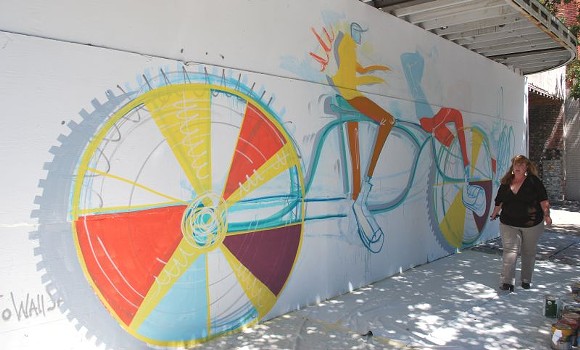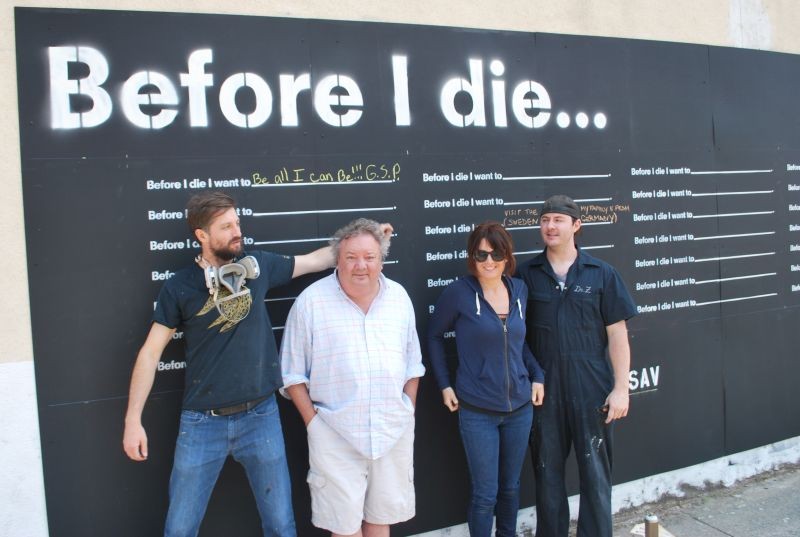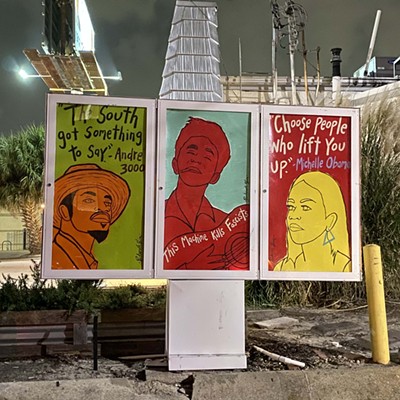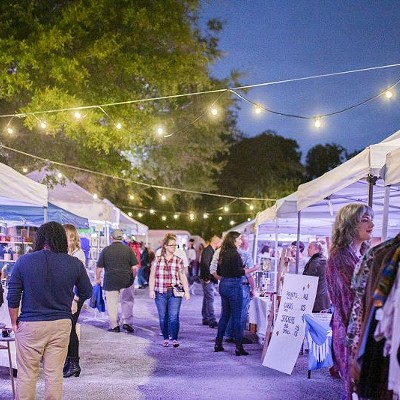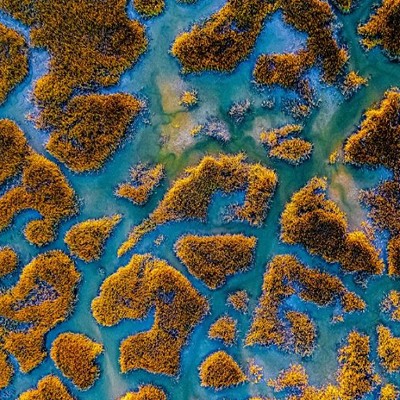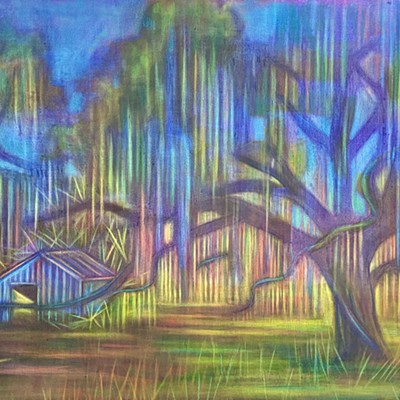FOR THOSE who support a more robust public art culture in Savannah, the good news is that the City’s mural policy remains unchanged after a hearing at the June 2 meeting of the Historic Site and Monument Commission.
The bad news? The City’s mural policy remains unchanged.
The HSMC called the hearing to review the efficiency and usage of the existing policy that was first conceived in 2012 by artists and SeeSAW founders Matt Hebermehl and James “Dr. Z” Zdaniewski and passed by City Council in 2013. Before that, anything on a wall other than a solid block of color that could be seen from a public right-of-way—whether on public property or private—was considered signage or graffiti and subject to removal by the city.
As it stands, artistic citizens now have an established protocol to navigate permission for their projects as well as a set of standards set by the HSMC, a division of the Metropolitan Planning Commission. (The MPC oversees zoning and development and makes recommendations to City Council but is not a part of City government.)
“For me, the process has always been very smooth,” says artist Jose Ray, who has contributed several murals around the city, including the façade of Revolution Yoga and the live oak reading nook at Drayton and 40th streets.
“The initial paperwork is thorough enough that by the time you get in front of the committee, they have a clear understanding of your plan, and the hearing itself is pretty easy. The main thing is to plan ahead, and be sure that a scheduled hearing falls within your timeline.”
The deal is simple enough: If you want to paint a wall, just fill out an application. And wait.
For some, the laborious nature of the process can be discouraging. HSMC meets monthly and often sends back projects for revision; a project can take several months to be approved. Artists are asked to provide a list of materials and exact dimensions for review, and the public is given 15 days to comment before anything goes up at a site.
Some artists find it easier to get forgiveness than permission. Projects like Panhandle Slim’s Walls of Hope, which has placed more than two dozen hand-painted portraits bearing inspiring quotes around the city, would have taken literally years to get through all the red tape had it gone through official channels. Art Rise Savannah recently defied the powers-that-be by installing a portion of a mural on the plastic sheeting in front of the construction zone of the new Kessler hotel, a move Art Rise director Clinton Edminster says was necessitated by the project’s time-sensitive parameters. (Edminster assures that an HSMC application for the rest of the 80-foot design is in the works.)
For those looking to do things by the books (and ensure that the city’s sanitation crews don’t remove their work), patience is required.
“Like many things here, the pace was slower than I would prefer; however, at the end of the day we were able to accomplish the first phase of our goal,” says Charlie Crosby, owner of the Welmont Gallery on West 35th Street that commissioned artist Maggie Hayes’ three-story depiction of boxer Jack Johnson.
But Crosby also appreciates HSMC’s role in vetting projects for the community and plans to submit future proposals, adding, “It was a pleasant realization to find the board reviewing these projects to be largely progressive, and ultimately in support of public art.”
The minutes reflect that: The HSMC has approved 13 out of the 14 mural applications it has received since 2013, including two of Candy Chang’s “Before I Die” blackboards and the seminal “Muralcle at 34th Street,” a multi-layered collaboration by Katherine Sandoz, Troy Wandzel and Adolfo Alvarado. (It has since been demolished to make way for the construction of a high-density apartment complex in 2014.)
The lone exception—a rendering of two kids on a bicycle by Hebermehl—was later authorized at a different location.
It’s a fine record that shows support for the cause. But many of the permits granted were temporary and have not added up to a wonderland of colorful walls. Plus, most of those 14 applications were submitted by the same handful of artists, and there are few proposals on the books for the future.
Why is that, in a city with such a tremendous pool of talent?
While other small Southern cities like Augusta and Greenville, SC are seeing a huge uptick in artistic participation in public projects, Savannah’s scene remains remarkably stagnant. Recognizing the desire for more public art and the lack of accompanying action, the six-person commission has called for a review of the policy and “how to make the process more user-friendly, efficient and available.”
But the ensuing discussion revealed that the problem may not lay with the policy but the limited power of the commission.
About 20 people—an unusually larger crowd for these meetings—showed up for the occasion to offer insight on the topic. HSMC chair Eli Karatassos told the room that any changes to the nascent policy would have to be considered carefully.
“We have to be cautious,” he warned. “We don’t want anything to happen to the mural ordinance. We like it.”
Karatassos also reminded that while the commission must adhere to basic moral standards and regulations governing historic materials, it doesn’t dictate style and is not there to serve as a “public tastemaker.”
In other words, “We don’t have to like it to approve it.”
Newly-installed commission member Dolores Engle echoed that changes should not be made to the policy, opining drily, “I think most good art is offensive to somebody.”
But the “one-size-fits-all” set of regulations can be problematic, restricting artists to the same considerations in the historic district as the crumbling industrial buildings on the Westside.
“It’s government overreach,” said board member Ryan Madson, a professor of urban design at SCAD. “The same set of standards might not apply to every area and corridor.”
The generality of the policy also can limit the definition of public art itself, which isn’t necessarily about making things prettier or fitting into its surroundings. Nor is it relegated to two-dimensional murals. (The confusion might be attributed to the HSMC master plan, which addresses “public art” in the same section as historic monuments while an entire chapter is devoted to the mural ordinance.)
Before MPC staff began its review of the mural policy, the commission (which also includes former Historic Review Board member Dr. Nick Henry, SCAD architectural history professor Thomas Gensheimer and arts writer Kristopher Monroe) was asked to weigh in on a proposal that appeared to be a challenge to grasp. Art advocate Erin Wessling approached the podium, seeking counsel on how to make Judge Realty at 347 Abercorn a permanent site for a revolving series of public art projects, utilizing not only paint but the entire multimedia toolbox of light, sound, sculpture and dimension.
The presentation detailed how the real estate office has already hosted several public art projects in the last three years, including the living horticultural creation “Savannah’s Mossterpiece,” by textile artist Jamie Bourgeois. By establishing the building as a sanctioned space and setting a precedent for others to do the same, owner Lori Judge and Wessling hope to streamline the “rigmarole” of HSMC process and get down to the business of bringing more art to the public.
“We’re seeking to produce projects on an increasingly larger scale in terms of grandeur and technicality,” Wessling explained to the commission, asking if the months-long vetting process could be shortened for frequent, known users.
There was question as to whether such innovation ought to be considered under the mural policy or the monument ordinance and if it falls under the HSMC’s purview at all. Some saw it as a zoning issue, others thought it ought to be run past City Council in a workshop.
Chairman Karatassos demurred responsibility, saying that the HSMC was only there to say “yes or no” to existing policies, not create new ones.
That led to a discussion of what role the city ought to play in public art, from compiling a map of potential sites to sponsoring programs to pay artists to create installations. The lack of input sought from the local art community on projects like the Cultural Arts Center and the Broughton streetscape were cited as examples of how artists have been shut out of public discourse while other cities actively seek not just to listen to them, but support them.
Augusta mayor Hardie Davis was in town recently to address the Savannah Downtown Business Association about his city’s revitalization efforts, which include using SPLOST funds to pay artists to paint 23 traffic signal boxes around the city.
Greenville, SC commissioned local artists to paint street sculptures for Mice on Main and converted parking garages into affordable studios. Phoenix, AZ found more than a million dollars in its budget to adopt a five year plan that employs artists in streetscape improvements and other city projects, incorporating aesthetics on freeway underpasses and on public transportation.
Such cases show that a strong public art scene doesn’t happen passively. It certainly can’t happen spontaneously, given the current climate of methodical approval. If Savannah wants more inspiring murals, more contemporary outdoor sculpture, more mind-blowing multimedia events, then artists must be given more than taciturn permission to create them—they need solid commitment and encouragement from city leaders.
That was confirmed by MPC Historic Preservation Director Ellen Harris, who helped craft the original mural ordinance.
“The board is only there to be reactive,” explains Harris.
“If people want to grow public art here, rather than take it to council workshop, it would be more productive to have a public forum and invite City Council and staff and the art community to continue this dialogue. The policymakers should hear the conversation.”
The HSMC meeting ended without a recommendation and far more questions than answers for the art community. But it’s clear that citizens want more opportunity to create positive change through public art, and momentum grows for a City-sponsored, tax-funded program.
In the meantime, the small commission still holds the power to greenlight public art projects, and might wield more by working with the art community.
“Committees like HSMC can be proactive in influencing policies that encourage the arts rather than merely regulating them,” said Madson after the meeting adjourned.
“There are a lot of pro-arts voices that need an official audience with the city.”

